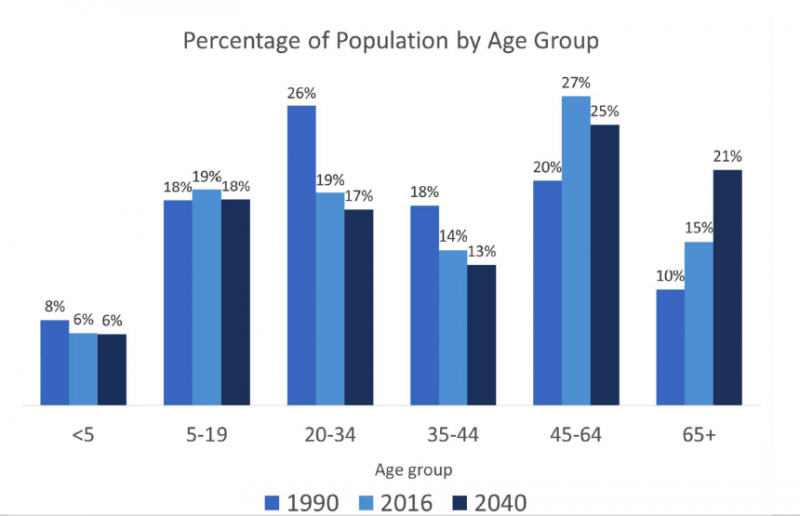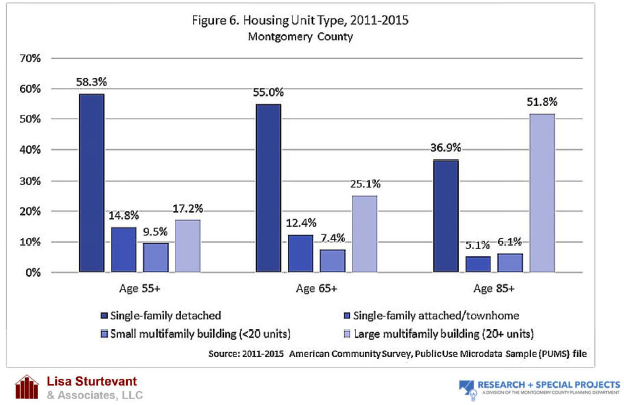Baby boomers desire urban amenities, but not necessarily cities

Potomac Village by Jordan Barab used with permission.
With a population of over 75 million, baby boomers have an enormous impact on American life. As more of them transition into retirement, they also promise to have a huge impact on the housing market and—potentially—the built environment. That’s because boomers increasingly desire urban amenities as they age.
Five panelists from the Washington region real estate and planning worlds discussed this shift at the Urban Land Institute Washington Chapter’s Real Estate Trends conference on Tuesday, April 30. The fastest-growing segment of Americans today is so-called “active seniors,” or younger seniors with good health, active lifestyles, and plenty of free time. Michael Hartman, principal at Capitol Seniors Housing, noted that this group typically looks for easily accessible eating and shopping, adaptable spaces, and low-maintenance housing.
Image by Michael Hartman used with permission.
These are all common characteristics of urban, transit-oriented communities that have the population density necessary to support robust public services, restaurants, and diverse activities. Yet this is a far cry from the sprawling suburbs where most boomers grew up. Moreover, these preferences won’t necessarily translate into mass migrations to urban centers.
Philip Kroskin, Senior Vice President of Real Estate at Sunrise Senior Living, remarked that most of their residents prefer to move to a home within a 15-minute drive of where they currently live. In these cases, developers can try to bring urban amenities in-house to their residents. The panelists agreed that the popularity of active living communities—which couple housing with various services like coordinated social events, meals, and transportation—is rising rapidly.
Typologies of senior housing
Image by Michael Hartman used with permission.
Janet Meyer, principal at BCT Architects, added that almost every senior housing project her firm sees now has some sort of an active living component. One of the most prominent examples of this in the region is Leisure World, a sprawling 610-acre gated community in Montgomery County with 8,000 residents and its own golf course, restaurants, tennis courts, and medical center.
Montgomery County Planning Director Gwen Wright noted that she does see a trend in development away from Leisure Worlds toward more urban infill projects, such as the Bonifant in downtown Silver Spring. This is perhaps symptomatic of the county’s burgeoning population of young seniors, its largest age cohort.
Montgomery county is aging, especially with young seniors
Image by Gwen Wright of the Montgomery County Planning Department used with permission.
Despite this, significant challenges remain for building dense, transit-oriented senior housing. Most Montgomery County seniors currently live in single-family homes, and more than three-quarters of the county is zoned for single-family housing or open space. Ironically, many of these senior homeowners are the same ones lobbying to make it impossible to build otherwise.
And Montgomery County is no exception to the region as a whole, where the vast majority of land is off-limits to multifamily development.
Most Montgomery County seniors live in single-family homes
Montgomery County Housing Unit Types by Gwen Wright of the Montgomery County Planning Department used with permission.
Wright recognizes this problem, noting that the county needs to “start thinking about adding some density in some spots where we haven’t had it,” especially on the edge of single-family zones. Of course, this isn’t easy politically. Wright emphasized that there is resistance to any sort of densification in much of the county. Hartman lamented this point, adding that his company has shifted focus to the Sunbelt, where he can easily find multiple acres of contiguous land, much less neighborhood resistance, and cheaper costs.
How much will baby boomers contribute to the region’s urbanization? Are we likely to see more Bonifants or Leisure Worlds for seniors in the near future? Only time, and more progressive land use policies, will tell.
